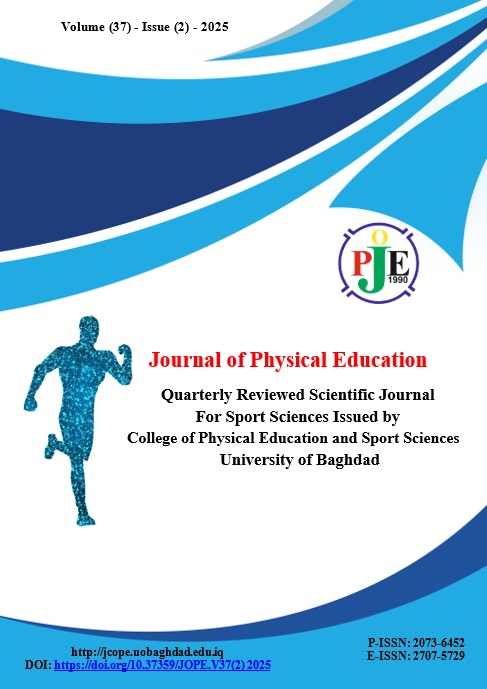Analysis of chaotic behaviour according to the playing lines of Iraqi Premier League football players
DOI:
https://doi.org/10.37359/JOPE.V37(2)2025.2204الكلمات المفتاحية:
Chaotic behaviour، game lines، football playersالملخص
This research aims to analyze the chaotic behaviour of Iraqi Premier League football players according to the lines of play (defense, midfield, and attack). Chaotic behaviour refers to player actions that may deviate from the expected tactics on the field, affecting team performance. In light of the increasing competition in the Iraqi Premier League, understanding the impact of this behaviour on collective performance is essential to improving the effectiveness of team tactical plans. The research problem lies in the emergence of disorganized behaviour among Iraqi Premier League players, which directly impact team performance. These behaviours vary in their impact depending on the player's position and line of play. The research focuses on determining whether chaotic behaviour supports creativity and changes the flow of play for the better, or whether it leads to team chaos and declining performance. The research sample was selected from Iraqi Premier League players, including players from various lines of play: defence, midfield, and attack. Players were divided according to their positions on the field to analyse their behaviour in matches. The study relied on an analysis of league matches using questionnaires to measure psychological and physical factors associated with disruptive behaviour. The disruptive behaviour were categorized and their impact on the team's tactical plans was determined. The results revealed that chaotic behaviour varied from one line to another. Its negative impact was most evident in defence, where it led to errors and an increase in goals conceded. In midfield, the effect was twofold, as it sometimes facilitated creativity and positive interaction with the game. In attack, chaotic behaviour was beneficial in creating unexpected new scoring opportunities. The study recommends developing training programs that target reducing chaotic behaviour in defence and promoting it in attack in positive ways. It also recommends using continuous analysis of player performance to identify and address unhelpful chaotic patterns, while enhancing the ability to innovate on the field within a controlled tactical framework.
المراجع
Abdul Rahman Al-Issawi. (undated). Psychology and production. Cairo: University Youth Foundation.
Abdul Rahman Muhammad Al-Aissawi. (1987). Physiological psychology is a study in the interpretation of humanity. Alexandria University, Faculty of Arts: Dar Al Maarefa University.
Ahmed Abdel Majeed Al-Qadhamawi. (1997). Educational psychology.UAE: Al Falah Library.
Ahmed Al-Zaghbi. (2011). The relationship between social intelligence and aggressive behaviour in ordinary or gifted students. Jordan: Jordanian Journal of Educational Sciences.
Ali Jaber Al-Rubaie. (1994). Human personality, its nature and disorders. Baghdad: General Directorate of Cultural Affairs.
Ali Muhammad Yasser. (2002).The effect of conditional teaching methods on developing some basic football skills. Tikrit University: PhD thesis, College of Physical Education.
Bandura, A. (1978). psychological modeling conflicting theories. Chicago: Aldine – Atherton.
Berkots, L. (1964). Aggressive Cusses in Aggressive Behaviour and Hostilely catharsis psycholrew.
Boeree, D., & George. (1998). (): Alpert Bandera: Personality Century co. Inc. Personality Century co.
Burns, B. (2002). (2002) : Reasons for children and Families. Aperpective and over view in B. Mums & K.K. Hoag wood (eds). Community treatment for youth Evidence based inter venations for severe emotional and behavioural disorders (pp.). New York: Oxford University.
C.R and Hill, R. (1967). Attitude measurement and predication of behaviour and evaluation of condition and measurement techniques (Vol. 30). soclometry.
Ferad. (1964). why war The Standard edition of the complete psychological works of sigmond feued. New. York. U.S.A.
Gupta, (1995). Comparison of adolescents fears from, Li No. (21) p. (212). Montreal and Vancouver, Canadian: Journal of school psychology.
Hamed Abdel Salam Zahran. (1973). Social psychology. Cairo.
Hassan bin Idris Abdo Al-Sumaili. (2009). The effectiveness of a rational guidance program in reducing chaotic behaviour among a sample of secondary school students in the Jazan Educational District.Jazan: Unpublished doctoral thesis, Umm Al-Qura University.
Hayat Ali Jassim. (2017). Intellectual stagnation, social exclusion, and their relationship to disruptive behaviour among university students. Baghdad: College of Education for Pure Sciences, Ibn al-Haytham.
Jamal Muhammad Al-Khatib. (2001). Behaviour modification for people with disabilities (a guide for parents and teachers). Amman, Jordan: Hanin Publishing and Printing House.
Kadhim, M. J. (2024). Social Networks’ Place in Contemporary Political Movements. International Journal of Social Trends, 2(2), 51–59.
Kadhim, M. J., & Mahmood, H. A. (2023). The effect of special exercises for some physical, motor and electrical abilities accompanied by symmetrical electrical stimulation in the rehabilitation of the muscles of the arms of patients with simple hemiplegic cerebral palsy. Journal of Physical Education, 35(3).
Karar Mohsen Rady. (2024).An analytical study to compare chaotic behaviour according to the playing lines and its relationship to the tactical thinking of advanced football players. University of Baghdad: College of Physical Education and Sports Sciences.
Khaled Ezz El-Din. (2010). Aggressive behaviour in children. Amman: Osama Publishing and Distribution House.
Khedir, S. Q. (2018). The Legal Protection and Regulation of Sponsorship Rights in English Football. University of Leeds.
Miller, P. (1983). Theories of development psychology. WH. Free man and compang. Francisco.
Nouri Ibrahim Al-Shawk and Rafeh Saleh Al-Kubaisi. (2004). Researcher’s Guide to Writing Research in Physical Education. Baghdad.
Saleh Mohammed Ali Abu Jado. (2003). Educational psychology. Dar Al Masirah for Publishing and Distribution: Amman.
Sami Girgis's longing for Moza. (2021). Chaotic behaviour and its relationship to some variables among students of the University of Baghdad.Baghdad: College of Education for Girls.
Sheltz Down. (1983). Personality theories. Baghdad: University of Baghdad, College of Arts.
Wahed Issa, F. A., Mohaif, S. M., & Kadhim, M. J. (2024). The effect of functional strength training according to gradually increasing load in developing some physical abilities and achievement for men’s 100-meter competition runners. Journal of Physical Education (20736452), 36(2).
التنزيلات
منشور
إصدار
القسم
الرخصة
الحقوق الفكرية (c) 2025 Journal of Physical Education

هذا العمل مرخص بموجب Creative Commons Attribution-NonCommercial 4.0 International License.






